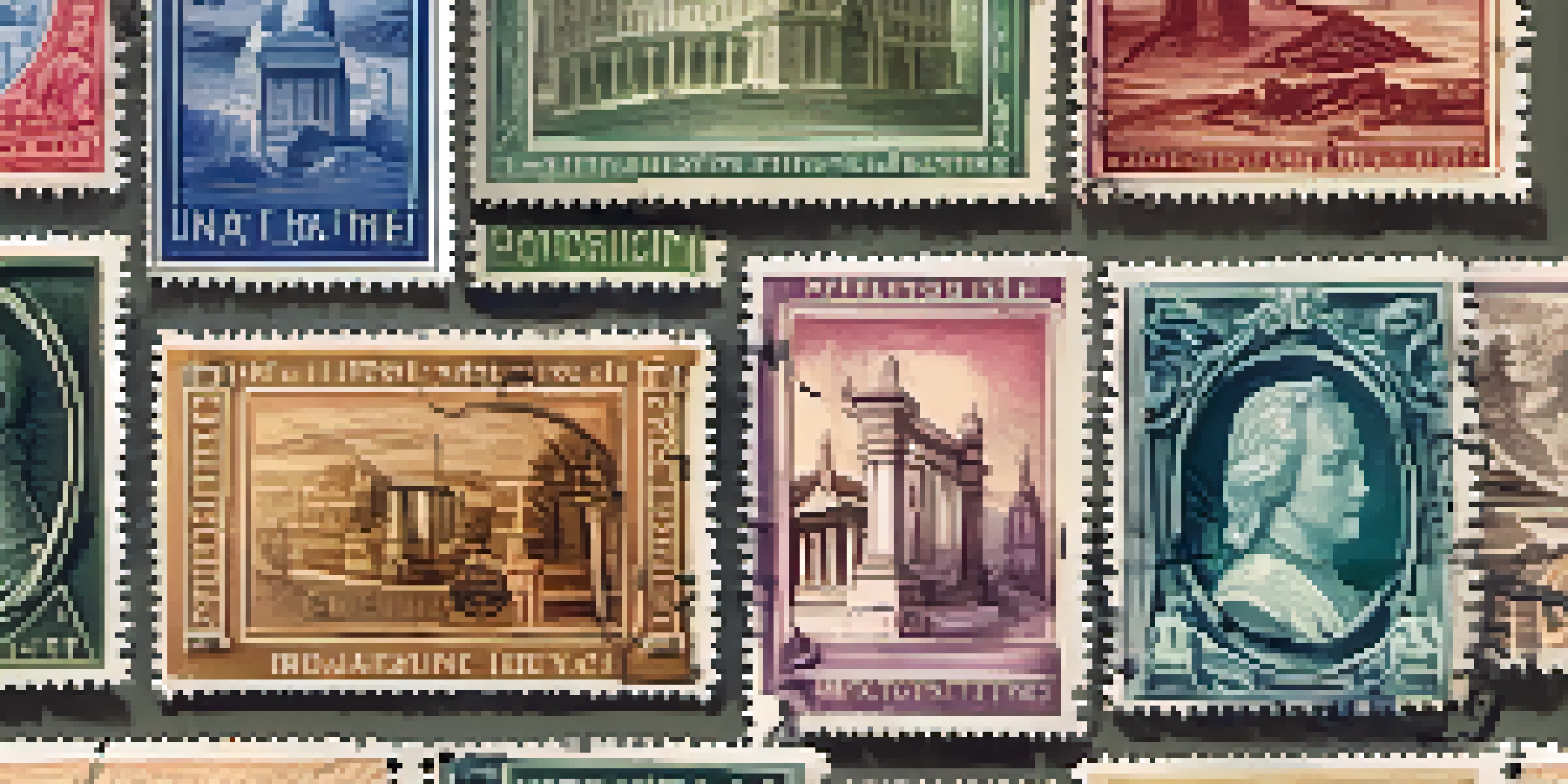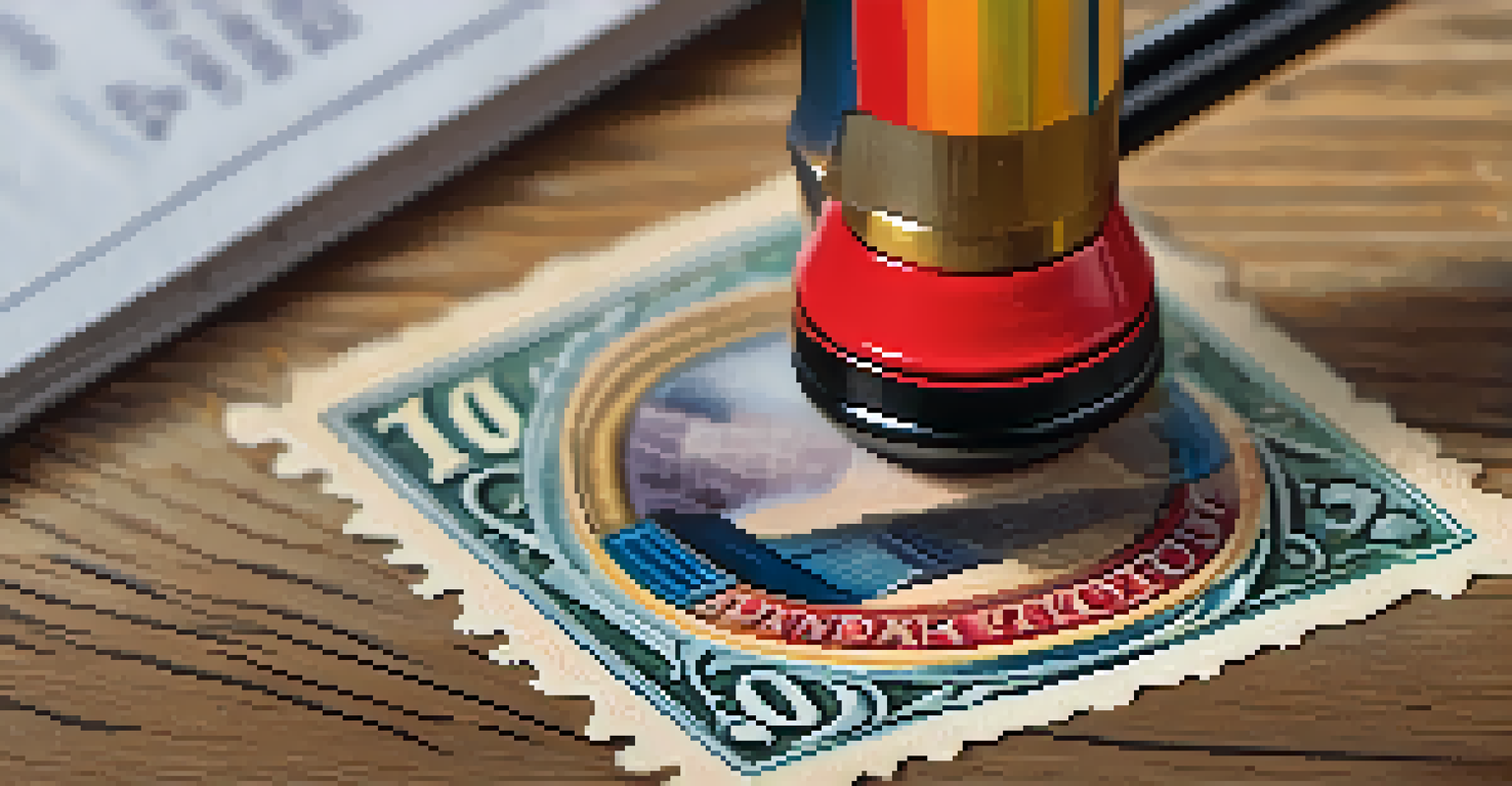How to Identify Rare Stamps: A Collector's Guide

Understanding What Makes a Stamp Rare
Rare stamps are often defined by their scarcity, historical significance, and unique features. For instance, a stamp that was printed in limited quantities or has a significant backstory can be highly sought after. The more unique the stamp's design or printing errors, the rarer it becomes in the eyes of collectors.
The value of a stamp is not just in its rarity, but in the stories it tells.
Additionally, the condition of a stamp plays a crucial role in its rarity. Stamps that are well-preserved, free from tears and fading, can fetch a much higher price. It's similar to how an old coin in mint condition is far more valuable than one that’s been heavily circulated.
Lastly, stamps can gain rarity based on market demand. A stamp that may not have been deemed rare in the past might suddenly become desirable due to a collector’s interest or a significant event. Keeping an eye on market trends is essential for any serious collector.
Researching Stamps: Tools and Resources
To identify rare stamps accurately, collectors need to utilize various research tools and resources. Catalogs, both online and in print, are invaluable for learning about different stamp issues and their values. Websites like the American Philatelic Society offer extensive resources for collectors of all levels.

Online forums and communities can also be a goldmine of information. Engaging with other collectors allows you to share insights, ask questions, and get tips about specific stamps or collections. It’s like having a group of friends who share the same passion and can offer their expertise.
Rarity Factors in Stamps
Stamps gain rarity from their scarcity, condition, and market demand, making unique features and historical significance essential for collectors.
Don't overlook local libraries and stamp clubs, either. Many libraries have philatelic sections, and joining a club can connect you with seasoned collectors who are eager to share their knowledge. The more you learn, the better equipped you'll be to spot a rare gem.
Recognizing Key Features of Rare Stamps
Identifying rare stamps involves recognizing key features that set them apart. Look for printing errors, such as misalignments or color variations, which can significantly increase a stamp's value. Think of it like finding a hidden treasure in a familiar place—those small, unexpected details can make a big difference.
Collecting stamps is like collecting history; each piece has a story waiting to be discovered.
Additionally, pay attention to the perforations on the edges of the stamps. A stamp with unique or irregular perforations can be quite rare and desirable. Familiarizing yourself with the standard perforation measurements can help you spot these distinctive stamps.
Moreover, stamps that feature historical figures or significant events often carry more weight. For example, a stamp commemorating a major milestone can be a collector's dream. Understanding the historical context behind a stamp can help you appreciate its rarity even more.
Evaluating the Condition of Stamps
The condition of a stamp is paramount when determining its rarity and value. Stamps are graded on a scale from poor to mint condition, with mint being the most desirable. A stamp in excellent condition is akin to a classic car that’s been kept in pristine shape—it’s worth much more than one that’s seen better days.
When evaluating a stamp, consider factors like centering, gum condition, and any visible defects. Even minor flaws can significantly impact a stamp's market value. It’s essential to be meticulous in your assessment, as collectors often seek perfection.
Using Resources for Research
Collectors can leverage catalogs, online communities, and local libraries to enhance their knowledge and spot rare stamps more effectively.
Using a magnifying glass can help you spot minute details that might not be visible to the naked eye. This simple tool can reveal hidden imperfections or unique characteristics that enhance a stamp's rarity. Remember, the more you know about what to look for, the better your chances of finding that elusive rare stamp.
Using Authentication Services for Rare Stamps
When it comes to rare stamps, authentication can be a crucial step in confirming their legitimacy. Many collectors turn to professional grading and authentication services to ensure their stamps are genuine. Much like having an expert appraise a valuable painting, these services provide peace of mind.
These organizations examine stamps meticulously and provide a grade that reflects their condition and authenticity. This grading can enhance a stamp's resale value, making it a wise investment for serious collectors. It’s an extra layer of protection that can save you from potential losses.
Moreover, having an authenticated stamp can make it easier to sell or trade in the future. Collectors are often willing to pay a premium for stamps that come with a guarantee of authenticity. In the world of stamp collecting, trust is everything, and authentication establishes that trust.
Networking with Other Collectors
Building relationships with other stamp collectors can help you identify rare stamps more effectively. Joining clubs or online communities allows you to share experiences and learn from others who share your passion. These connections can provide valuable insight and tips for finding rare stamps.
Attending stamp shows and conventions is another excellent way to meet fellow collectors. These events often feature seminars, workshops, and discussions that can deepen your knowledge of rare stamps. It’s like attending a mini-university for stamp lovers—full of opportunities to learn and engage.
Importance of Authentication
Authentication services provide valuable verification of a stamp's legitimacy, enhancing its resale value and establishing trust within the collecting community.
Moreover, networking can lead to potential trade opportunities. Many collectors are willing to swap stamps or share leads on rare finds. Building a community not only enriches your collecting experience but can also open doors to discovering those elusive rare stamps.
Staying Updated on Market Trends
The stamp market is constantly evolving, and staying updated on trends is vital for collectors. Regularly checking auction results, price guides, and collector publications can help you gauge the current market value of rare stamps. It’s a bit like following a stock market—knowledge is power.
Furthermore, subscribing to newsletters or joining online forums dedicated to stamp collecting can keep you informed about upcoming auctions and rare stamp sales. These platforms often highlight valuable stamps that are on the market or have recently been sold, giving you insight into what’s trending.

Being aware of market fluctuations can also help you make informed decisions about buying or selling. If you know that a particular stamp is gaining popularity, you might want to acquire it before prices soar. Staying in the know is key to navigating the world of rare stamps successfully.